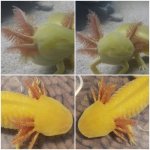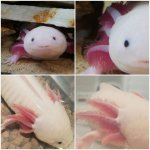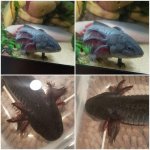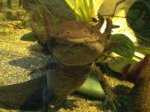Alecann
New member
So I've looked around the forum for posts relating to my issue, but I haven't found any that match exactly. So I made a new thread.
I have 3 axolotls, they are about 8 months old, I got them 5 months ago. They have been very healthy, and in fact, are considered to be on the large side. I noticed my golden albino's gill filaments were getting shorter about a month ago, but he wasn't acting sick. Then I notice my melanoid was having the same issue about 2 weeks ago, finally, about a week ago I saw that my leucistic's began to shrink. I also noticed the albino and leucistic had a reduction in appetite, but it's not consistent, and each changes their mind daily, some days neither will eat, some days one will eat and not the other. The melanoid has had no change in appetite, and still eats nearly every day.
I keep the water between 63°f-66°f, and it has only ever gotten to 67° one time, several months ago, never gotten any higher than that though.
I have high ph in my area because we have very hard water the ph in freshly added water is 8.1, and in the cycled tank it reads 7.9-8.0. I know they prefer hard water, so I do nothing to change the ph.
My ammonia reads .00ppm except during the initial cycling, but that was months ago.
Nitrite is the same, always reads .00ppm except back when first cycling.
Nitrate regularly reads 5ppm, but they have had 2 nitrate spikes(40ppm, neither spiked was for extended times, no more than 1-2 days), one was a couple of months ago, and one was last week while I was out of town. I had someone to care for them, but at the last minute they informed me that they had to care for a relative post-op during the same days I would be gone, so they couldn't stay at my house, only come by once per day instead. If I had the choice I'd have stayed home, but this trip was not optional, unfortunately.
I test my water 3-4 times per week, and do 25% water changes about 2-3 times per week, if I don't, the nitrates climb. I clean their waste every day, I spend close to 2 hours a day caring for them.
I found a vet a couple of weeks ago, and made an appointment for the day after I was to return home, so I took them to the vet 3 days ago.
The vet was an exotic pet vet who had told me they had a couple of clients with axolotls that they treated already. They didn't find anything conclusive, or really have an answer to ease my concerns. They took a sample of the golden albino's filaments and a skin scraping, but found nothing under their microscope. They said perhaps I should try an antibiotic in case it was a bacterial thing. So they gave me flagyl, they did the first injection, and said I'd need to do one every 3 days for the next 9 doses, so 10 total doses. Except the vet injected it into the front arm of the axolotls. I thought injections should be given in the body of an axolotl?
I'm worried that the vet didn't really know enough about axolotls, and am considering going yo another for a second opinion. I've already spent about $200 for the first vet, and don't know if another will be less or more. I hate wasting money on useless information, or worse, information that can actually harm them.
The vet suggested adding products (Am-Quel Plus, Seachem Denitrate) to my tank to reduce the nitrate levels. I am extremely hesitant to add chemicals to my tank, as many can be deadly to axies.
The vet also mentioned the reason for shrinking of their filaments could be hyperoxygenation, due to my frequency of water changes. I know the theory of hyperoxygenation and gill loss is one that has been argued both ways. I haven't found anything conclusive yet, so I am not fully convinced that it actually happens.
I have been keeping them in individual 3 gallon plastic storage tubs since returning from the vet, with 100% water changes daily, and offering a combo of bloodworms, brine shrimp, and salmon pellets every day.
I stopped feeding earth worms when I got home from my trip, because the last 4 containers of worms I purchased looked unhealthy, they're not thick and muscular, but thin and limp looking.
While they're housed in the tubs I've decided to change their substrate from fine aquarium sand, to slate tiles, which I'm attaching and sealing with silicone aquarium sealant. (Thoughts on this route could be helpful too) I'm sure that will help with cleaning, sand is very dirty I've found, and almost impossible to fully clean out.
Sorry this is ridiculously long, I am trying to give all of the information I can think of, to maybe find some help with answers.
So any experts on here that could help with the shrinking gills, or any insight on the theories of the vet?
I've attached some photos of before and after photos I took just tonight.
The pics of the golden were taken right when I first thought his filaments might be shrinking, and you can see that they clearly were, they're almost gone now. He's always had less feathery filaments than the other 2, but they were still a good length.
The leucistic and melanoid have photos showing full feathery filaments, and now shorter, stubby, thinner filaments.
I have 3 axolotls, they are about 8 months old, I got them 5 months ago. They have been very healthy, and in fact, are considered to be on the large side. I noticed my golden albino's gill filaments were getting shorter about a month ago, but he wasn't acting sick. Then I notice my melanoid was having the same issue about 2 weeks ago, finally, about a week ago I saw that my leucistic's began to shrink. I also noticed the albino and leucistic had a reduction in appetite, but it's not consistent, and each changes their mind daily, some days neither will eat, some days one will eat and not the other. The melanoid has had no change in appetite, and still eats nearly every day.
I keep the water between 63°f-66°f, and it has only ever gotten to 67° one time, several months ago, never gotten any higher than that though.
I have high ph in my area because we have very hard water the ph in freshly added water is 8.1, and in the cycled tank it reads 7.9-8.0. I know they prefer hard water, so I do nothing to change the ph.
My ammonia reads .00ppm except during the initial cycling, but that was months ago.
Nitrite is the same, always reads .00ppm except back when first cycling.
Nitrate regularly reads 5ppm, but they have had 2 nitrate spikes(40ppm, neither spiked was for extended times, no more than 1-2 days), one was a couple of months ago, and one was last week while I was out of town. I had someone to care for them, but at the last minute they informed me that they had to care for a relative post-op during the same days I would be gone, so they couldn't stay at my house, only come by once per day instead. If I had the choice I'd have stayed home, but this trip was not optional, unfortunately.
I test my water 3-4 times per week, and do 25% water changes about 2-3 times per week, if I don't, the nitrates climb. I clean their waste every day, I spend close to 2 hours a day caring for them.
I found a vet a couple of weeks ago, and made an appointment for the day after I was to return home, so I took them to the vet 3 days ago.
The vet was an exotic pet vet who had told me they had a couple of clients with axolotls that they treated already. They didn't find anything conclusive, or really have an answer to ease my concerns. They took a sample of the golden albino's filaments and a skin scraping, but found nothing under their microscope. They said perhaps I should try an antibiotic in case it was a bacterial thing. So they gave me flagyl, they did the first injection, and said I'd need to do one every 3 days for the next 9 doses, so 10 total doses. Except the vet injected it into the front arm of the axolotls. I thought injections should be given in the body of an axolotl?
I'm worried that the vet didn't really know enough about axolotls, and am considering going yo another for a second opinion. I've already spent about $200 for the first vet, and don't know if another will be less or more. I hate wasting money on useless information, or worse, information that can actually harm them.
The vet suggested adding products (Am-Quel Plus, Seachem Denitrate) to my tank to reduce the nitrate levels. I am extremely hesitant to add chemicals to my tank, as many can be deadly to axies.
The vet also mentioned the reason for shrinking of their filaments could be hyperoxygenation, due to my frequency of water changes. I know the theory of hyperoxygenation and gill loss is one that has been argued both ways. I haven't found anything conclusive yet, so I am not fully convinced that it actually happens.
I have been keeping them in individual 3 gallon plastic storage tubs since returning from the vet, with 100% water changes daily, and offering a combo of bloodworms, brine shrimp, and salmon pellets every day.
I stopped feeding earth worms when I got home from my trip, because the last 4 containers of worms I purchased looked unhealthy, they're not thick and muscular, but thin and limp looking.
While they're housed in the tubs I've decided to change their substrate from fine aquarium sand, to slate tiles, which I'm attaching and sealing with silicone aquarium sealant. (Thoughts on this route could be helpful too) I'm sure that will help with cleaning, sand is very dirty I've found, and almost impossible to fully clean out.
Sorry this is ridiculously long, I am trying to give all of the information I can think of, to maybe find some help with answers.
So any experts on here that could help with the shrinking gills, or any insight on the theories of the vet?
I've attached some photos of before and after photos I took just tonight.
The pics of the golden were taken right when I first thought his filaments might be shrinking, and you can see that they clearly were, they're almost gone now. He's always had less feathery filaments than the other 2, but they were still a good length.
The leucistic and melanoid have photos showing full feathery filaments, and now shorter, stubby, thinner filaments.





